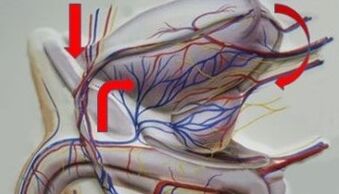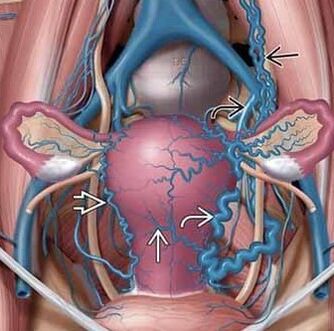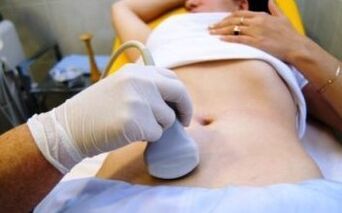For many doctors, varicose veins of the pelvis (WRMW) or the chronic pelvic pain syndrome are still an exotic illness with blurred diagnostic limits.
This explains the fact that some doctors do not notice this disease for their patients for a long time, while others make this diagnosis for almost every second person with constant inexplicable pain in the lower abdomen.

In the meantime, the quality of the further life of the patient, his ability, the intimate side of relationships with a loved one and the ability to continue his family, largely depends on the timely detection of varicose veins, largely from the timely detection of varicose veins.
Description of the disease, its prevalence, statistical data
The phenomenon of chronic pelvic pain has long been known to the doctors. But it was only recently the best -known reason - varicose veins of the pelvis. This is a diseaseIt was first described in 1975And still not well studied.
It is most likely that this pathology will develop according to the following algorithm:
- The venous plexus in the pelvis is a complex formation that includes large vascular strains and smaller veins that extend from them. At the same time, the venous system of small pelvis in men and women differs in its structure, which determines the sexual specification of the disease - vrvMTIt is much more common with the representatives of weaker sex.
- Due to pressing vessels, complete or partial constipation of the venous channel, changes in the tone of the vessel walls are disturbed by the blood drainage from deep pelvic veins.
- As a result, veins stop fulfilling their functions:The lack of venous valves progressAnd a normal blood drainage is disturbed.
- Stagnant phenomena begin in the pelvic veins that are associated with the blood cast through the vessels - this provokes the extent of the veins and the development of varicose veins.

Symptoms of varicose veins (varicose) of the veins of the internal organs of the pelvis are much more common in women in reproductive age than in men. At the same time, ovarian ("ovary") veins suffer most frequently - in 85% of cases.
The leading symptom is the pain that is recorded in more than 90% of the patients. However, the prevalence of this disease in the population has not yet been clarified: according to various studies, it is between 6 and 80%. Such a big run in the "certificate" is only explained by the inadequate qualifications of diagnostic doctors in the diagnosis.
Causes and risk factors
The causes of pelvic messicates are all changes in the body that can provoke the start of the pathological mechanism of this disease:
| The anatomical and physiological cause of varicose veins | What can lead to it |
| Mechanical compression of the pelvic veins |
|
| Change the sound of blood vessels |
|
| Constipation of the veins of the pelvis |
|
High risk factors VRVMT are:
- tense physical work;
- Inadequately regular or unsatisfactory sex life;
- Abuse in intimate life through interrupted sexual intercourse;
- a large number of pregnancies and birth;
- Common gynecological diseases;
- Concept with hormonal drugs;
- Hormonal malfunctions in the body;
- Hypodynamics.
Classification and stages of varicose veins
In the medical environment, the conditional separation of VRVMT is accepted by the type of course in varicose veins of the step and the external genitals (e. g. labia) and venous Plethora syndrome.
Since then, this classification has not been very practicalIn most cases, patients have both formsProvoke like each other at the same time.
You can also find a classification of the disease through the basic cause of your appearance. In this regard, VRVMT is divided into:
- Primary- caused by the unsatisfactory work of venous valves;
- secondary- develops as a complication of existing inflammatory, gynecological or oncological diseases of internal organs.

What is dangerous and whether there will be consequences
This type of vascular pathologycannot be called a fatal disease. Discovered in time, it is well suited for medical correction. But the whole problem is that it is not so easy to find it. The inadequate knowledge of the disease and the low awareness of most diagnostic doctors play a role.
It turns out that patients have been suffering from this disease for years without suspecting them. And now in your bodyThere are a number of irreversible changes:
- The varicose progress, neighboring areas are included in the pathological process - the expansion of the veins of the reproductive organs (e. g. varicose veins of the penis), perineum and the lower extremities appear.
- Persistent dysfunction of the internal genital organs appears thatcan lead to infertility or inability to endure pregnancyIn women.
- Against the background of pain syndrome, various psychoemotional disorders develop from the type of neurasthenia.
- Due to chronic pain, which make it difficult for intimacy, a person can completely give up sex.
- The rarest and at the same time the most severe complications of pelvic varicose veins are viewed as thrombosis of the veins and the thromboembolism of the lungs. SheMeet around 5% of cases, but always fatal.
Diagnosis
According to American researchers, only 2% of patients with VRVMT initially made the correct diagnosis in the early 2000s. Sometimes the result of a diagnostic error was the removal of detergent organs in women, although this could be avoided if they were usedThe most precise methods for diagnosing pelvic messicas:
- Ultrasound and Dopplerographic examination of the veins- enables varicose veins to be assumed;
- Phlebography- Invasive study, which enables it with great accuracy to determine the presence and degree of the disease;
- Laparacopia- In the differential diagnosis of VRVMT from the differential diagnosis of symptoms of gynecological diseases (endometriosis, myoma, colpitis).
- Selective ovariography- The examination of the venous state by introducing a contrast matter is regarded as the most objective diagnostic method.
- Computer or magnetic resonance imagingYou can clarify the details of the course of the disease and distinguish them from others that are not hydroxological pathologies that are similar in symptoms (joint diseases, disease crohn, etc. ).

Forecasts and preventive measures
It is almost impossible to completely heal varicose veins of the small pelvis without surgical intervention. With the help of conservative medicineYou can make most unpleasant symptoms easier and even removeAnd significantly reduce the risk of disease complications. The operation also does not offer a hundred percent guarantee that the disease does not return.
To prevent a relapse into illnessIt is always necessary to adhere to an "anti -variable" lifestyle:
- Smoking prohibited;
- Do not use hormonal medication uncontrollably;
- Move more and stand motionless on your feet;
- Observe an anti -SS -Clertetics diet with a large amount of fresh plant feed;
- Perform a complex of therapeutic gymnastics and breathing exercises every day to maintain the health of blood vessels.
- After a surgical surgery for VRVMT, it is necessary to wear compression knitting clothes and to take preventive doses of venotonics medication that are prescribed by the doctor.
Pelvic varicose veins -This is a hidden scourge of the health of women, a kind of ghost diseaseWhat is difficult to find, but suffering from it is pretty real.
The main symptom of the disease is a chronic pelvic pain that can torture the patient for a long time and become a source for the task of many joys of life. You cannot endure such symptoms and do not see a doctor!
If certain symptoms occur, you have to understand clearly that it is abnormal and that help from a specialist immediately seek help.

Basic therapy
In such things as the treatment of varicose veins of the pelvis, the basis is to correct his diet. First of all, women with VRVMT should learn that even Detralex has no efficiency if they do not refuse to work in harmful production.
If there is such an opportunity, it is better to switch to an easier job - without excessive physical activity and lifting weight.
If you have to sit or stand for a long period of time during a working day, arrange 5-minute breaks every half hour. At this point you can just go or lie down or do therapeutic gymnastics.
A high treatment of varicose veins is also not possible without changes in nutrition. From nutrition it is necessary to completely remove fat and fried foods, smoked food and nature conservation. Use as few citrus fruits as possible. Try to use spices less frequently when cooking.
Add other natural products to your daily menu - fruit and vegetables. Use instead of animal fat vegetable - you contain a large amount of B -vitamine E.
With the painful expansion of the veins of the pelvis, it is necessary to carry special compression laundry. We speak of tights or stockings that contribute to normalizing the bloodstream in the vessels and also eliminate the stagnation of liquid in the veins.
In addition to all the people mentioned above, women with VRVMT should be busy with VRVMT every day. It contains the following exercises:
- Swimming in the pool or open ponds with clean water;
- Morning jogging;
- Bicycle skiing;
- Drive or skate.
A daily shower helps to tighten the veins. Therate the area of the hips, stomach and buttocks with nozzles of different temperatures.
Pharmaceutical therapy
If the disease of the pelvic veins is in the early stages of development, you can try to cope with medication with it. The degree of damage can be determined by ultrasound (ultrasound examination of the veins of the pelvis).
Very often varicose veins of the pelvis are found during pregnancy. If a woman will soon give birth, it is necessary to stabilize her condition as early as possible.
Preventive measures
Forever, get rid of the varicose veins of the pelvis without using surgical interventions is almost unrealistic. However, the ships never expand themselves, which means that problems can be avoided by adapting their lifestyle.
Even after surgical intervention, you will not receive an absolute guarantee that the disease does not return. Of course, modern conservative methods considerably simplify the treatment process and recovery. You can only avoid relapse if you follow a number of rules:
- Smoking Weigen;
- The cause of varicose veins of the pelvis in women often occupies hormonal contraceptives that are incorrectly selected.
- If you try to be physically active, make you work frequently.
- Observe a diet for cramping a small pelvis - consume a lot of natural foods from the plant chair;
- Keep the vessels in the tone, the implementation of therapeutic exercises for varicose veins of the pelvis and maintain breathing exercises.
- Follow all the recipes of the doctor in the recovery phase after surgical interventions - apply compression underwear, take the medication in good time.

Folk remedy
In order to alleviate symptoms and accelerate the restoration of the affected veins, the use of traditional medicine means. However, do not use natural medication with the doctor without prior consistency.
List of effective recipes:
- Ginger (4 tablespoons) and lemon peel are cast with boiling water (1 l). After cooling, the infusion (2-3 el L. ) is added honey. The drink is used instead of tea.
- Horse Chestnut (200 g) is crushed and cast with vodka (1 l). The tool is infused in a dark place for 7 days. Recommended dosage: 10 drops 3-4 times a day for one month.
- The branches of oaks, pastures and chestnuts in a shredded form (1 tablespoon) are poured into a pan, cast with boiling water (1 l) and placed on a low fire. Half an hour after cooking, the decoction is removed from the stove and cooled. Next, chamomile, series, drying and St. John's wort (1 tablespoon) are added. The deadline is 12 hours. A little honey should be placed on the filtered medication.
The decoction scheme: the first 2 days - 3 by 50 ml, the next 2 days - 100 ml, in the future the dosage increases to 150 ml. The therapy duration is 20 days, according to which a break is taken for 10 days.
To improve the condition of the blood vessels, it is useful to use blueberries and flower pollen every day.
When using folk remedies, it is important to understand that they only add the main course. It is therefore undesirable to refuse medication that is prescribed by a doctor.
The regular medical examination is not low, so that you can recognize a deviation in good time and continue for therapy. The earlier the disease is recognized, the easier it is to get ready. Heavy cases require longer treatment.
Drugs of the veins of the pelvis without pronounced symptoms can be eliminated by conservative methods. They fight with a neglected disease with the help of an operation, even after surgical manipulations, a repeated occurrence of the pathology is possible.
It is possible to minimize the risk of VRVMT thanks to prevention, which implies a healthy lifestyle.



















